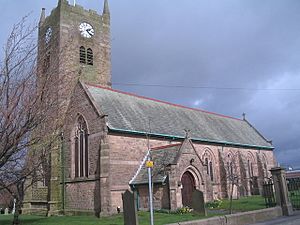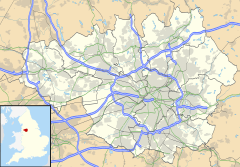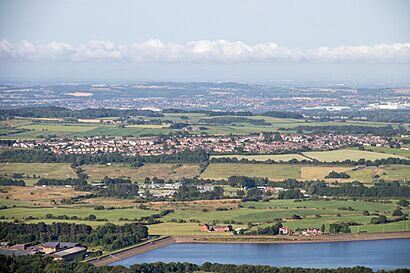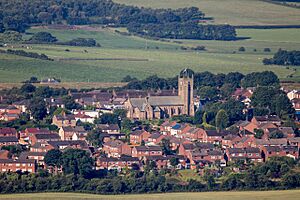Blackrod facts for kids
Quick facts for kids Blackrod |
|
|---|---|
 Blackrod's parish church of St Katharine |
|
| Population | 5,345 (2021 Census) |
| OS grid reference | SD615105 |
| • London | 177 mi (285 km) SE |
| Metropolitan borough |
|
| Metropolitan county | |
| Region | |
| Country | England |
| Sovereign state | United Kingdom |
| Post town | BOLTON |
| Postcode district | BL6 |
| Dialling code | 01942/01204 |
| Police | Greater Manchester |
| Fire | Greater Manchester |
| Ambulance | North West |
| EU Parliament | North West England |
| UK Parliament |
|
Blackrod is a small town in Greater Manchester, England. It's also a civil parish, which is a local area with its own council. Blackrod is located in the historic county of Lancashire.
The town is about 3.9 miles (6.3 km) northeast of Wigan. It is also 6.6 miles (10.6 km) west of Bolton. In 2021, about 5,345 people lived in Blackrod. Long ago, Blackrod was an important place for coal mining.
Contents
History of Blackrod
What Does the Name Blackrod Mean?
The name Blackrod comes from old English words. Blaec means "dark" and rodu means a "clearing" in a forest. So, Blackrod might mean "dark clearing."
The town was first mentioned in 1189. It was called Blacherode back then. Later, it was known as Blakerodein in 1200 and Blacrode in 1220. Some people think "rod" might also refer to the "Holy Rood," which means the Cross of Christ.
Blackrod's Roman Past
Blackrod is believed to have been a Roman station. The Romans built a fort on the north side of the town. This area is now a residential place called Castle Croft. The A6 road follows the path of an old Roman road. This road passes below the hill where the town is built.
Who Owned Blackrod?
In the early 1100s, William Peverel owned the land of Blackrod. But the king took it from him. In 1190, it was given to Hugh le Norreys. Later, the manor was passed down through his family.
A woman named Mabel Norris inherited Blackrod. She married Roger de Bradshaw. The manor stayed with the Bradshaw family until the 1500s.
Arley Hall was another important estate in the west of the town. It was once a moated manor house. Today, the Wigan Golf Club is located on this site.
Blackrod's Industrial Growth
After the Industrial Revolution, coal mining became the main industry in Blackrod. There was also a brickworks. In 1869, several coal mines were working in the area. These included Anderton Hall and Scot Lane Colliery.
Scot Lane Colliery was a very large mine. In 1923, it employed 628 men underground. It also had 122 workers on the surface. This colliery closed in 1932. Blackrod also had factories for bleaching and printing fabric. A weaving mill was built in 1906.
How Blackrod is Governed
Local Government Changes
Blackrod has been part of Lancashire county since the 1100s. It was a small church area called a chapelry. It was also a township within the larger Bolton le Moors parish.
In 1872, the Blackrod Local Board of Health was created. This board helped manage local services. In 1894, it became the Blackrod Urban District. This meant Blackrod had its own local government.
However, things changed in 1974. The Local Government Act 1972 made Blackrod part of the Metropolitan Borough of Bolton. This borough is in Greater Manchester.
Blackrod Today
Today, Blackrod is a civil parish. This means it has its own local council. The Blackrod Town Council helps manage local matters for the town.
Geography of Blackrod
Blackrod is located on hilly land. It is near the River Douglas. The town is west of the West Pennine Moors. It covers an area of about 2,344 acres.
The M61 motorway runs west of Blackrod. This motorway separates Blackrod from Horwich. Besides the main Blackrod village, there are smaller areas. These include Little Scotland and Scot Lane End.
Red Moss Nature Area
Between Blackrod, Lostock, and Horwich is Red Moss. This is a special natural area. It is 116.6 acres (47.2 hectares) in size.
Red Moss was named a Site of Special Scientific Interest (SSSI) in 1995. This means it's important for its biology. It is the best example of a lowland raised mire in Greater Manchester. The Wildlife Trust for Lancashire, Manchester and North Merseyside helps manage this site.
Population Changes in Blackrod
How Many People Live Here?
The population of Blackrod has changed over many years. Here is a look at how the number of people living in Blackrod has grown or shrunk since 1801:
| Population changes in Blackrod since 1801 | |||||||||||||||||||||||||||||||||||||||||||||||||||||||||||||||||||||||
|---|---|---|---|---|---|---|---|---|---|---|---|---|---|---|---|---|---|---|---|---|---|---|---|---|---|---|---|---|---|---|---|---|---|---|---|---|---|---|---|---|---|---|---|---|---|---|---|---|---|---|---|---|---|---|---|---|---|---|---|---|---|---|---|---|---|---|---|---|---|---|---|
|
|
|
|||||||||||||||||||||||||||||||||||||||||||||||||||||||||||||||||||||
| Sources: (a) Local population statistics. (b) A vision of Britain of through time. (c) Neighbourhood Statistics. | |||||||||||||||||||||||||||||||||||||||||||||||||||||||||||||||||||||||
Education in Blackrod
Schools Through the Years
The first school in Blackrod was Blackrod Grammar School. It was started in 1586 by John Holmes. The original building is no longer there.
In 1875, Blackrod Grammar School joined with Rivington Grammar School. Later, in 1973, it became Rivington and Blackrod High School. This school is in Horwich and provides secondary education for many students from Blackrod.
Today, Blackrod has two primary schools. These are Blackrod Anglican Methodist Church School and Blackrod Primary School. A third school, Scot Lane End CofE Primary School, closed in 2008.
Religion in Blackrod
St. Katharine's Church
The first mention of a church in Blackrod was in 1338. A woman named Dame Mabel de Bradshagh helped pay for a priest. This priest would hold services in the chapel of St Catherine.
The current church is dedicated to St Katharine of Alexandria. It has a Norman design, which means it's very old. Some parts of the church are from the Elizabethan era (late 1500s).
The church has been made bigger and changed many times. It was enlarged in 1776. Galleries were added in 1837. The roof was fixed in 1894. The chancel (the area around the altar) was rebuilt in 1905. The main part of the church (nave) was rebuilt in 1911.
The spelling of the saint's name changed over time. It was Catherine, then Katharine. The church has six bells in its west tower. They were first made in 1776. They were fixed up in 1922. The clock was lit up in 1947. The bells were fully refurbished in 2015.
Transport in Blackrod
Getting Around Blackrod
Blackrod has its own railway station. It is on the Manchester to Preston Line. This station opened in 1841. There was also a branch line from Blackrod to Horwich. Special train lines also served the coal mines.
The main road through Blackrod used to be the A6. This road connects Manchester to Preston. Now, the A6 goes around the town centre. The B5408 road goes through the town. There are also roads connecting Blackrod to Horwich and Aspull.
The M61 motorway is a major road nearby. It connects the M60/M62 motorways (around Manchester) to the M6 (near Preston). The M61 was opened on November 28, 1969.
Media in Blackrod
Local News and Entertainment
People in Blackrod can watch local news and TV shows from BBC North West and ITV Granada. Television signals come from the Winter Hill TV transmitter. This transmitter is northeast of the town.
Local radio stations include BBC Radio Manchester and Heart North West. There's also Smooth North West and Greatest Hits Radio Bolton & Bury. Other stations are XS Manchester, Capital Manchester and Lancashire, and Bolton FM. Bolton FM is a community radio station based in Bolton.
The Horwich Advertiser is a local newspaper. Other regional newspapers include The Bolton News, Manchester Evening News, and North West Enquirer.
See also
 In Spanish: Blackrod para niños
In Spanish: Blackrod para niños




